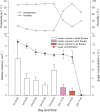Pollinator responses to floral colour change, nectar, and scent promote reproductive fitness in Quisqualis indica (Combretaceae)
- PMID: 27072926
- PMCID: PMC4829896
- DOI: 10.1038/srep24408
Pollinator responses to floral colour change, nectar, and scent promote reproductive fitness in Quisqualis indica (Combretaceae)
Abstract
Floral colour change is visual signals for pollinators to avoid old flowers and increase pollination efficiency. Quisqualis indica flowers change colour from white to pink to red may be associated with a shift from moth to butterfly pollination. To test this hypothesis, we investigated Q. indica populations in Southwest China. Flowers secreted nectar continuously from the evening of anthesis until the following morning, then decreased gradually with floral colour change. The scent compounds in the three floral colour stages were similar; however, the scent composition was different, and the scent emission rate decreased from the white to red stage. Dichogamy in Q. indica prevents self-pollination and interference of male and female functions. Controlled pollinations demonstrated that this species is self-incompatible and needs pollinators for seed production. Different pollinators were attracted in each floral colour stage; mainly moths at night and bees and butterflies during the day. Observations of open-pollinated inflorescences showed that white flowers had a higher fruit set than pink or red flowers, indicating the high contribution of moths to reproductive success. We concluded that the nectar and scent secretion are related to floral colour change in Q. indica, in order to attract different pollinators and promote reproductive fitness.
Figures






References
-
- Melendez-Ackerman E., Campbell D. R. & Waser N. M. Hummingbird behavior and mechanisms of selection on flower color in Ipomopsis. Ecology 78, 2532–2541 (1997).
-
- Aragón S. J. & Ackerman D. Does flower color variation matter in deception pollinated Psychilis monensis (Orchidaceae)? Oecologia 138, 405–413 (2004). - PubMed
-
- Weiss M. R. Floral color change: a widespread functional convergence. Am. J. Bot. 86, 167–185 (1995).
-
- Weiss M. R. & Lamont B. Floral color change and insect pollination: a dynamic relationship. Isr. J. Plant Sci. 45, 185–199 (1997).
-
- Willmer P., Stanley D. A., Steijven K., Matthews I. M. & Nuttman C. V. Bidirectional flower color and shape changes allow a second opportunity for pollination. Curr. Biol. 19, 919–923 (2009). - PubMed
Publication types
MeSH terms
Substances
LinkOut - more resources
Full Text Sources
Other Literature Sources
Molecular Biology Databases

